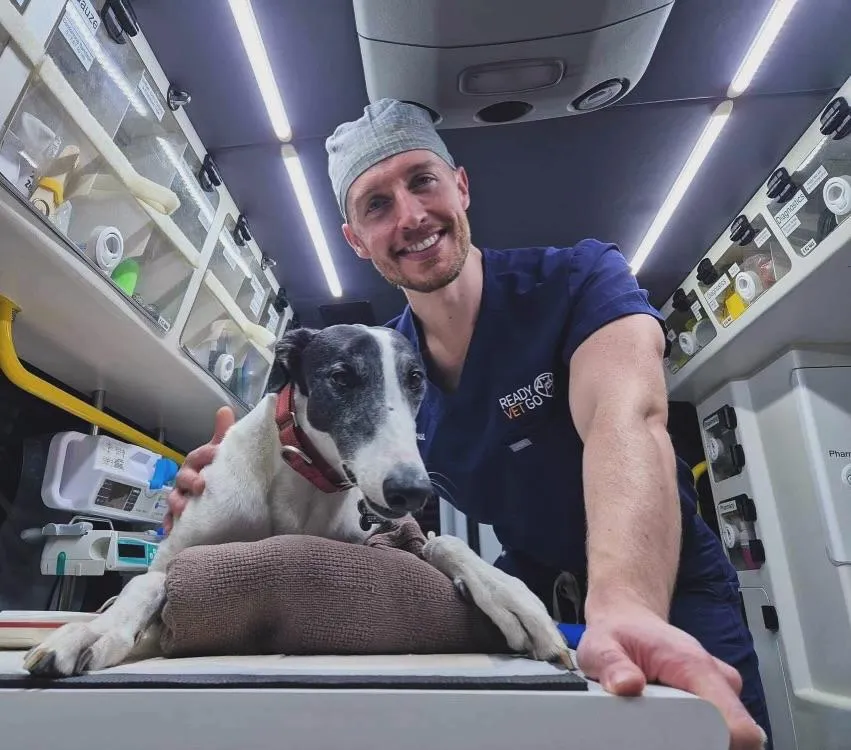PAWSITIVE PET PODCAST
Pawsitive Pet Adventures: Lessons from Pet Heroes

Past Blogs

Veterinary Paramedics and Cardiac Emergencies: Insights with Dr. Paul Cunningham from ReadyVetGo
“Tracking your pet’s respiratory rate at home is a simple way to monitor their heart health and catch any early warning signs.”- Dr. Paul

Meet Dr. Paul Cunningham: From Rural Beginnings to Leading Pet Paramedics in Australia
Growing up surrounded by animals on farms in rural Oklahoma, Dr. Paul never envisioned that he’d one day lead an emergency pet ambulance service in Australia. His journey included years of academic and emergency vet practice in the U.S., and later, a desire to provide high-level emergency services for pets here in Australia. ReadyVetGo, which he founded with his partner Nick (a registered nurse), meets the critical need for paramedic services tailored to pets.
Dr. Paul: “In vet medicine, we’ve made massive advances in specialties like cardiology, but paramedic services were lagging. ReadyVetGo exists to fill that gap.”
ReadyVetGo is currently the only service in Australia that operates with a vet on board at all times, offering in-home urgent care, vet-led paramedic support, and transport for pets. They are looking to expand beyond Melbourne into other major Australian cities, where demand for this specialised service is increasing.
Recognizing Signs of Heart Disease in Pets
With heart conditions often being “silent” in pets, knowing the subtle signs of heart disease can make all the difference. Dr. Paul highlights a few common symptoms that might indicate heart issues in dogs and cats:
Exercise Intolerance: If your pet isn’t able to exercise as they once did, or tires easily, this could be a red flag.
High Resting Respiratory Rate: Breathing over 35 breaths per minute at rest may indicate a heart or lung issue.
Laboured Breathing or Coughing: If your pet is extending their neck or struggling to catch their breath, it’s time for a vet visit.
Dr. Paul: “Tracking your pet’s respiratory rate at home is a simple way to monitor their heart health and catch any early warning signs.”
Heart Attack vs. Cardiac Arrest in Pets: Key Differences
One of the most misunderstood aspects of pet health is the difference between heart attacks and cardiac arrest. While these conditions are often used interchangeably, they differ significantly in pets:
Heart Attack: In pets, a “heart attack” typically means a temporary disruption in blood flow or oxygen, often causing fainting or shortness of breath, but the heart keeps beating.
Cardiac Arrest: This is a complete halt in heart function, which can be caused by arrhythmias or other issues. Immediate action and CPR are required in these cases.
Dr. Paul explains that pets do not experience the same type of artery blockages as humans, making true “heart attacks” rare in the veterinary field. Instead, conditions like heart failure or congenital heart defects are more common culprits.
Dr. Paul: “Pets don’t get plaque in their arteries like humans do. Instead, heart issues often stem from genetics or structural problems.”
The Most Common Causes of Cardiac Arrest in Pets
For dogs, congestive heart failure—where the heart valves degrade over time and hinder blood flow—is a common cause of cardiac arrest. Symptoms may emerge gradually, sometimes over years, making regular vet check-ups essential for early diagnosis.
In cats, feline aortic thromboembolism (FATE) is a silent but deadly condition where blood clots form in the heart and block blood flow, often causing sudden and severe symptoms like paralysis in the back legs.
Dr. Paul: “Cats can have hidden heart conditions that only become apparent in an emergency, making regular screenings crucial.”
Emergency Response: Performing CPR on Your Pet
Knowing how to perform CPR on your pet could save their life in an emergency. Dr. Paul outlined the steps for effective pet CPR:
Position Your Pet: Lay your pet on their side (unless they have a broad chest like a bulldog).
Find the Heart Location: For smaller pets, position your hands just behind the elbow over the heart. For larger pets, place your hands over the widest part of the ribcage.
Chest Compressions: Aim for 120 compressions per minute—about two compressions per second.
Administer Breaths: Seal your mouth over their snout, ensuring no air escapes, and give one breath every six seconds. If you’re alone, do 30 compressions followed by two breaths.
Dr. Paul: “Effective compressions are key. Focus on a steady rhythm to keep blood flowing to the organs.”
If possible, have a friend or family member call ReadyVetGo or your nearest emergency vet for guidance as you perform CPR.
Preparing for a Pet Emergency
In addition to learning CPR, Dr. Paul recommends being proactive by taking pet first aid courses and downloading resources from the Recover Initiative, which offers CPR techniques and algorithms for pets. He emphasises the importance of preparing for emergencies in advance and keeping emergency numbers on hand.
Dr. Paul: “Having tools and information ready means you’re prepared, which can make all the difference when every second counts.”
Do’s and Don’ts of Pet CPR
Do:
Begin Compressions Immediately: Keeping up a steady rate is essential to build up circulation.
Check the Airway: Quickly check for obstructions like toys or food.
Stay in Contact: Call your emergency vet for guidance if you’re unsure.
Don’t:
Stop Compressions Unnecessarily: Keep the flow steady until help arrives.
Use Excessive Force: Compressions should be firm but controlled—smaller pets require gentler pressure than larger ones.
Long-Term Care and Monitoring for At-Risk Breeds
Certain breeds are predisposed to heart issues, making regular vet visits and early detection crucial. For example, Cavalier King Charles Spaniels often develop valve-related issues, while Boxers are prone to arrhythmias. Cats can also have hidden conditions, with Sphinxes being particularly susceptible to hypertrophic cardiomyopathy (HCM), a thickening of the heart muscle.
Dr. Paul: “Preventative care is the best way to ensure your pet lives a full, happy life, even if they’re prone to heart issues.”
How ReadyVetGo Can Assist During a Cardiac Emergency
For pets needing immediate help, ReadyVetGo’s unique service brings the emergency room to you. With oxygen support, advanced life support medications, and monitoring equipment, Dr. Paul and his team can provide rapid-response care, ensuring your pet gets the treatment they need without delay.
To learn more about ReadyVetGo’s services, or to get Dr. Paul’s expert insights on emergency pet care, tune in to our full podcast episode at pawsitivepet.com.au/podcast.
Closing Thoughts
With expert insights and practical tips from Dr. Paul Cunningham, this episode of Pawsitive Pet Care is a must-listen for pet owners who want to stay prepared for emergencies. Don’t miss this informative discussion that could help you save your pet’s life in a crisis.
For the full episode, additional resources, and more on pet care, check out our website pawsitivepet.com.au/podcast. Interested in joining us as a guest speaker? Book your spot here.
Hashtags:
#PetFirstAid #PetCPR #ReadyVetGo #EmergencyPetCare #PawsitivePetPodcast #PetHeartHealth #VetParamedics #PetSafety #AustraliaPets #DogCPR #CatCPR #VeterinaryCare
Copyright Seos 2019 -- All Rights Reserved
We’re on a mission to build a better future where technology creates good jobs for everyone.
Call 03 8364 8984
Email: Hello@pawsitivepet.com.au
Site: www.pawsitivepet.com.au

Facebook
Instagram
LinkedIn
Youtube